SUMMARY
This is AI generated summarization, which may have errors. For context, always refer to the full article.
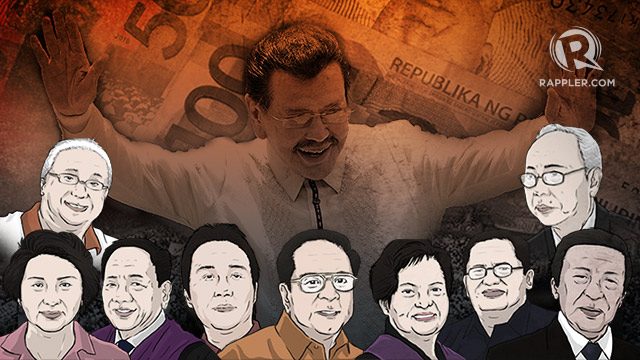
MANILA, Philippines (UPDATED) – It’s been nearly 2 decades since the plunder indictment of former president Joseph Estrada. He was arrested, jailed and granted a presidential pardon not long after.
The man who captured the public’s imagination and adulation with his breakthrough gangster movie hit, Asiong Salonga, was both the hero and the anti-hero in the plunder case. The plot was strikingly similar to most of the movies he starred in, with betrayal, revenge, and justice as the overarching themes.
If it were a film, Estrada’s plunder trial could be his most expensive movie yet, taking 6 years to finish.
Looking back, it was a scuttled attempt on the life of an ex-gambling buddy Luis Chavit Singson, that triggered it all. This led to a dramatic impeachment trial, a second People Power revolt, his eventual downfall and trial before the Sandiganbayan. (READ: No closure yet on Erap Estrada’s plunder case)
Many of the cast of characters in the plunder trial have mostly faded from public view. Where are they now? We checked on 9 of them who played significant parts in the plunder story. Here’s what we found.

Jaime Dichaves: Estrada’s loyal friend
As the self-confessed owner of the dummy Jose Velarde account that contributed to the downfall of Estrada, Jaime Dichaves has successfully employed legal strategies to keep himself out of jail. While his patron, including the son, spent some time under hospital arrest while they faced the plunder charge, this Chinese Filipino businessman, who was once described as Estrada’s Number One crony, managed to elude arrest, return triumphantly and trump authorities with legal maneuvers.
Dichaves returned to the country in October 2011, 4 years after Estrada was convicted of plunder, and a month after the Sandiganbayan recalled the arrest warrant issued against him in 2001. Just as he eluded immigration authorities when he supposedly left for China to hide, he slipped back quietly as if he were not a fugitive for 10 years.
In November 2010, with the pardoned Estrada almost pulling off his biggest political comeback by placing second in the presidential race, Dichaves decided it was time for his own comeback. He filed a motion to quash the plunder case against him, arguing on the basis of a technicality in the Plunder Law. He got the go-signal to return in September 2011, and after a month, it was as if he just took a long vacation.
Dichaves managed to convince the anti-graft court that he was denied due process by the Ombudsman. The Ombudsman was ordered to conduct a fresh preliminary investigation on his case. As expected, the Ombudsman – now under former Justice Conchita Carpio-Morales – sustained its earlier findings that Dichaves is liable for plunder.
But just before a new arrest warrant was issued, Dichaves ran to the SC and sought a reprieve. Again, he got what he wanted: a temporary restraining order that prevented the anti-graft court from proceeding with his arraignment.
In the meantime, he has rekindled his relationship with Estrada, catching up on lost time. Just like old times, he was always seen with Estrada. In fact, he was spotted partying, dining and wining with Estrada in a family affair where pork barrel queen Janet Lim Napoles was also present.
Based on court records, Dichaves is president of Plaster Glass Manufacturing Inc, with a supposed annual income of P200 million. In 2013, he attempted to join Estrada’s entourage in a trip in Hong Kong, Bangkok and Tokyo, but was disallowed travel by the Sandiganbayan.
Since then, however, Dichaves was allowed to travel abroad at least twice: to China in November 2015 by the Sandiganbayan Special Division, and to Hong Kong and Japan in mid-2016 by the SC Second Division.
Dichaves is proof that while Lady Justice may be blindfolded, the balance of scales remains tilted in favor of those who have the resources.
In recent years, however, the scales seem to be tipping against him. In January 2017, the SC junked Dichaves’ 2013 petition against the Ombudsman, effectively bringing him to trial at the Sandiganbayan after nearly 16 years.

Charlie “Atong” Ang: The ‘traitor’ is still a gambler
Estrada gambled big-time on his former fair-haired boy, and he lost big-time too. Charlie “Atong” Ang triggered the rift between Estrada and Ilocos Sur Governor and jueteng lord Luis “Chavit” Singson. Estrada favored Ang by giving him the go-signal to operate the Bingo 2-ball, which threatened to put Singson out of his illegal business. A supposed attempt on Singson’s life set the motion for Estrada’s ouster.
Like Dichaves, Ang fled the country and hid in the US. True to form, he got caught while gambling in Las Vegas. Citing political persecution, he managed to stay in the US by posting a $300,000 bail and staying under house arrest. He was extradited to the country in November 2006.
With his former patron out of power, Ang entered into a plea bargain by pleading guilty to the lesser charge of corruption of public officials. In exchange, he admitted diverting the P130 million tobacco excise tax for Ilocos Sur province, and delivering it personally to Estrada. This validated the testimony of Singson. He also returned P25 million which represented his commission from the tobacco excise tax.
While on probation, Ang could not shake off his past gambling past. He supposedly found work as consultant to a Cambodian gaming firm and a local gaming firm, Lucky Tytanium Corporation, a small town lottery operator in Cavite.
In 2009, he was a totally free man, having served out the two-year probation imposed on him by the anti-graft court for his plea bargain.
In 2010, he was tagged by Senator Miriam Defensor-Santiago as one of the top jueteng operators – a charge which he denied, saying he is against illegal gambling. He worked as consultant for gaming firm Meridien Vista Gaming Corporation, which operates in the Cagayan Special Economic Zone and Free Port.
With gambling in his genes, Ang has reinvented himself as a cockfighting aficionado, financing cockfighting teams in high-roller competitions. He co-founded the Ultimate Fighting Cock Championship, whose supposed goal is to promote “discipline, respect, sportsmanship and camaraderie” among cock-fighting fans.
Ang has also figured one way or another in the administration of President Rodrigo Duterte. In April 2017, Ang accused then-justice secretary Vitaliano Aguirre and National Security Adviser Hermogenes Esperon of wanting him killed so they could “control” the operation of small-town lottery in many provinces. This fizzled out 3 months later when Ang made a brief courtesy call at Aguirre’s office, and expressed support for the Duterte administration.
In January 2018, Duterte said in a speech that he reached out to Ang for him to help Philippine Charity Sweepstakes Office (PCSO) stop illegal gambling.
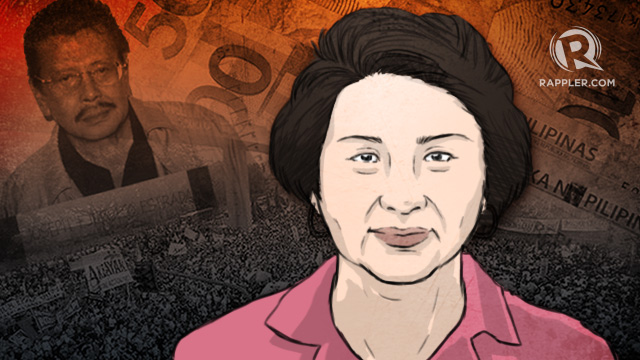
Yolanda Ricaforte: Ruby Tuason she’s not
Just like Estrada’s crony, Dichaves, and gambling consultant Atong Ang, Yolanda Ricaforte fled the country when Estrada’s ship started to sink. Tagged as the accountant-auditor of the former President tasked to keep track of his kickbacks and commissions, Ricaforte also served as his bagwoman.
During the plunder trial, bank officials testified that Ricaforte opened several accounts and deposited millions of pesos. She told bank officials that she was into real estate and a fish pond business in Iloilo.
In his testimony before the anti-graft court, Estrada said he came to know Ricaforte through her husband, Orestes Ricaforte, whom he appointed as tourism undersecretary. At the behest of Orestes, Estrada appointed her director of San Miguel Campo Carne Corporation to help the couple financially. The deposed president denied she was under his employ as keeper of his supposed jueteng proceeds.
In its ruling, the anti-graft court observed that Ricaforte helped Estrada illegally enrich himself through connivance and participation. The Court, however, withheld any judgment on her role, limiting the decision to Estrada’s conviction and the acquittal of his son Jinggoy and lawyer Edward Serapio.
Like Dichaves, nothing was heard of Ricaforte for 10 years. On Oct 17, 2011, however, through her lawyer Pacifico Agabin, she asked the Court to quash the charge sheet against her, also citing technicalities.
Using the law, which she sought to elude as her refuge, Ricaforte argued that she was denied due process by the Ombudsman when it filed the plunder case against her.
Just like Dichaves, Ricaforte won a reprieve after the Sandiganbayan remanded her case to the Ombudsman for preliminary investigation. However, it was only a temporary respite as Ombudsman Conchita Carpio-Morales upheld the filing of information against her.
At this point, it was clear that Ricaforte had no intention of returning to the country, with her lawyer Agabin admitting that she is still not in the country. On two separate occasions, Ricaforte failed to appear for her arraignment, prompting the Sandiganbayan to issue an arrest warrant against her – for the second time.
Ricaforte, it seems, has no intention of following the footsteps of Ruby Tuason.

Dennis Villa-Ignacio: Fallen from grace
The former Special Prosecutor, who led the team that pursued former President Estrada in the plunder charge before the Sandiganbayan left public service on a sour note. Even before Estrada was convicted, Villa-Ignacio and Ombudsman Merceditas Gutierrez, who replaced his former boss, Simeon Marcelo, had a simmering tension that led to his fall from grace.
Villa-Ignacio caught the ire of former president Arroyo when he took positions that ran counter to Malacañang’s. In 2006, he castigated then presidential chief of staff Michael Defensor for suggesting that Malacañang was open to the idea of giving then president Estrada temporary freedom. He said Malacañang should not meddle in legal issues. He also spoke openly against the pardon on Estrada, which came shortly after his conviction.
Clearly a pain in the neck for Arroyo, Villa-Ignacio was targeted for ouster, and Gutierrez was more than willing to oblige. She was suspected to be behind the estafa case against Villa-Ignacio lodged by a colleague in 2008 with the Office of the Ombudsman. In this case, he was accused of diverting donation money for the construction of water pumps in areas ravaged by Typhoon Milenyo to Gawad Kalinga.
(In December 2014, the Court of Appeals found Villa-Ignacio guilty of misconduct over this incident. Nonetheless, the Supreme Court in February 2017 threw out the estafa case against him.)
When this case did not stick at the time, Gutierrez slapped Villa-Ignacio with an administrative case of serious dishonesty for faking records. An investigation of his attendance supposedly showed he was absent for work for 113 days in 2008, while his secretary-daughter was reportedly absent for 166 days in the same year.
On the basis of this finding, Gutierrez ordered his removal from office.
Villa-Ignacio believed Malacañang wanted him removed to give Arroyo a free hand in appointing a new Special Prosecutor. He was officially sacked by the Ombudsman in November 2008.
Villa-Ignacio questioned the ruling before the Court of Appeals. The appellate court sustained his dismissal in February 2014, and upheld it with finality in January 2016.
Villa-Ignacio was appointed by former Ombudsman Aniano Desierto to lead the prosecution in the plunder and perjury charges filed against Estrada and his cronies.
At first, the legality of his designation as special prosecutor was questioned, since he was a Cabinet undersecretary during that time and was not supposed to serve in another position. Desierto, however, explained that Villa-Ignacio was allowed to act as “deputized prosecutor” pursuant to the Ombudsman Act of 1989.
Prior to this, he served as prosecutor of the Department of Justice (DOJ), was a military trial court lawyer, and presiding judge in regional trial courts in Makati.
He remained with the Ombudsman after the trial ended in 2007, and handled the case against retired Armed Forces comptroller Major General Carlos F. Garcia.
In 2010, Villa-Ignacio was nominated by former Ombudsman Simeon Marcelo to the position vacated by then retiring Supreme Court Justice Chief Justice Reynato Puno. His nomination marked the first time a judiciary outsider was nominated to the said position.
Arroyo, however, appointed then SC Associate Justice Renato Corona. Years after, Villa-Ignacio would “silently help” the prosecution panel in the Corona impeachment trial. He now teaches law part-time at the Ateneo Law School.
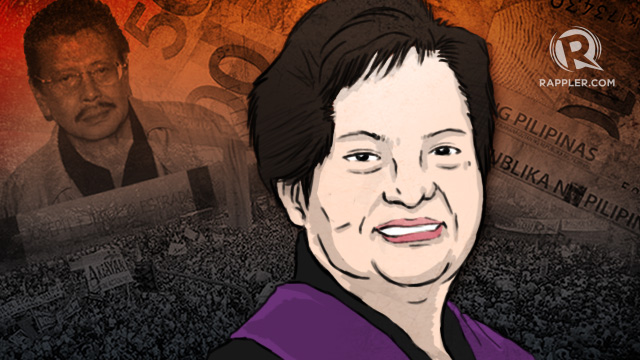
Teresita Leonardo-de Castro: Taking the cudgels for Arroyo appointees
Now a member of the Supreme Court, Justice Teresita Leonardo-De Castro was the presiding justice and at the same time chairperson of the special Sandiganbayan that handled the trial of Estrada for plunder. Only 3 months since the special division handed down its verdict, De Castro was appointed by former president Arroyo to the High Tribunal.
De Castro got unsolicited advice from critics – including Arroyo’s then presidential legal adviser Sergio Apostol – that she should decline the position out of delicadeza. Furthermore, she should spare Arroyo further criticism that she was appointing her as a reward for Estrada’s conviction.
She did not heed it, went through interviews by the Judicial and Bar Council (JBC), and assumed the post vacated by SC associate justice Cancio Garcia. She was sworn into office in December 2007.
She denied claims she had convicted Estrada in exchange for a seat on the Supreme Court, saying she was nominated to the post even before she got involved in the case. But that’s precisely the point: it gave Arroyo more reason to appoint her to the SC.
With the ouster of Corona, Arroyo’s former chief of staff in the Senate and one of her first appointees in the SC, De Castro took the cudgels for other Arroyo appointees in the SC.
She was at the forefront of criticizing policies being implemented by ousted chief justice Maria Lourdes Sereno, who was appointed by Aquino as Corona’s replacement. She publicly got entangled with Sereno over the reopening of the Regional Court Administration Office, and the deletion of her recommendation in the Temporary Restraining Order for the proclamation of winning party-list groups in the May 2013 elections.
De Castro also mentioned these issues during her unprecedented testimony before the House justice committee that heard the impeachment complaint against Sereno in November 2017.
Sereno was eventually ousted in May 2018 by her own colleagues when they granted the quo warranto petition filed against her on the basis of an invalid appointment. De Castro was among the 8 justices who voted for the quo warranto petition.
Three months later, in August 2018, President Duterte picked De Castro to replace Sereno as Chief Justice. Her appointment, which will last for only two months, was met with criticism. (READ: The test of legacy for Chief Justice De Castro)

Diosdado Peralta: Patience is a virtue
Like Justice Teresita Leonardo-De Castro, Peralta was amply rewarded by Arroyo for the conviction of Estrada. Although he had to wait it out, he finally got appointed to the Tribunal in January 2009.
In March 2008, Peralta replaced De Castro as presiding justice of the Sandiganbayan. It was only a matter of time before he would rejoin his former colleague, De Castro, in the Supreme Court.
Peralta would later on inhibit in 2012 from a plunder case involving Arroyo, where she was charged with allegedly misusing P366-million worth of intelligence funds of PCSO.
He was named an automatic nominee, along with 4 other senior magistrates, to replace Corona after he was ousted in 2012. He, however, declined the nomination.
For a short time, Peralta headed the JBC, which vets nominees to the judiciary. It was a post given to him on a silver platter.
With Corona’s ouster, the JBC chairmanship was supposed to be headed by senior Justice Antonio Carpio. But after Carpio accepted his chief justice nomination, the JBC post landed on Peralta’s lap.
The JBC was short-term, however, lasting only two months. The top JBC post was assumed by Maria Lourdes Sereno following her appointment as chief justice.
After Sereno’s ouster in May 2011, Peralta made the shortlist of candidates vying to replace her. Her long-time colleague De Castro was chosen as the new Chief Justice.
Peralta finished law at UST and worked in the lower courts. He was appointed to the Sandiganbayan in 2002.
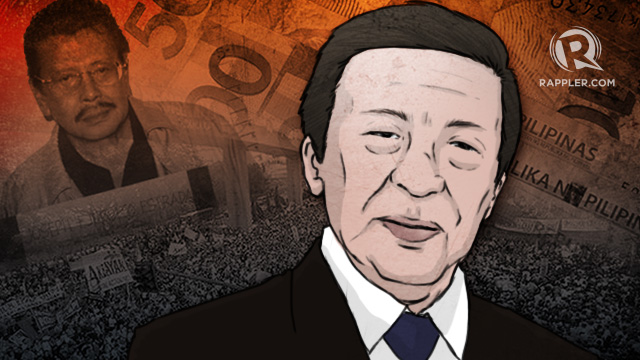
Francisco Villaruz Jr: The one who didn’t make it
Out of the 4 justices that oversaw Estrada’s conviction, only Justice Francisco Villaruz Jr did not make it to the Supreme Court. He became presiding justice of the Sandiganbayan though, until the age of retirement caught up with him.
A graduate of the UP College of Law in 1967, Villaruz had worked in the private sector before being appointed Associate Justice of the Sandiganbayan in 2001.
Villaruz got a shot at the SC when Associate Justice Garcia vacated his post. Just like De Castro, he was also advised by Apostol to decline his nomination.
In hindsight, he could have waited it out since he was contesting the post with De Castro in the first place. He got bypassed and never got any second chance for the SC.
Villaruz was promoted presiding justice of the Sandiganbayan two years after the Estrada verdict in October 2011. He replaced Justice Edilberto Sandoval who retired in June 2011.
Before he retired, Villaruz figured in a minor row with his colleagues in the Sandiganbayan, after he refused to raffle the case involving the controversial plea bargain of retired Major General Carlos Garcia. Sources said Villaruz handpicked the two justices included in the second division, an accusation he denied.
Villaruz retired in June 2013, and was replaced by current Presiding Justice Amparo Cabotaje-Tang.
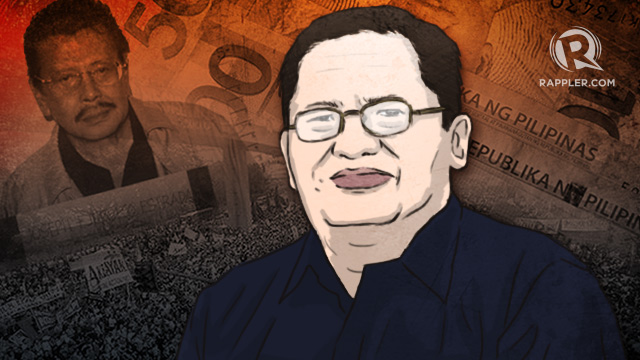
Edward S. Serapio: Back to Estrada’s service
Lawyer Edward Serapio spent more than two years in jail before the Sandiganbayan allowed him to post bail in connection with the Estrada plunder case. He was dragged to the scandal as corporate secretary of the ERAP Muslim Youth Foundation which got P200 million in jueteng proceeds. Ilocos Sur Governor Luis “Chavit” Singson channeled the jueteng money as donation to the foundation and the unsuspecting Serapio said he did not know it came from tainted sources.
Serapio was introduced by Lito Banayo to Estrada in 1999. Impressed by his resume – a former seminarian, a bar topnotcher who graduated valedictorian from the Ateneo de Manila Law School – Estrada tapped him as presidential assistant for political affairs, with the position of undersecretary. He was then senior partner of the De Borja Medialdea Bello Guevarra Serapio & Gerodias law firm.
That he would get involved in the plunder charge came as a surprise since he was the odd-man out in the snake-pit that is Malacañang. He did not engage in power-play and was reportedly using the “merienda room” in the Palace as his office.
“They say I’m antisocial. I’m a nobody, I’m just like the barber of the president. I’m wary of power, I don’t like to be in the limelight. I value privacy so much I did not even bring my family to Malacañang…The only state dinner I was forced to attend was when two tables were empty because guests did not appear, so I was obliged to go,” he said in an earlier interview with Newsbreak.
In his testimony before the Sandiganbayan, Estrada said he was informed by Serapio that a donor, who wanted to remain anonymous, gave P200 million to the foundation. Instinctively realizing that it was from Singson, Estrada told Serapio to return the money. “I’m sure it’s from jueteng,” Estrada told Serapio.
For some reason, the money, however, was not returned to Singson.
Wanting to isolate Estrada, the prosecution offered Serapio the option of turning state witness, which he turned down. Insisting on his innocence, he said turning state witness would be tantamount to admission of guilt. In hindsight, maybe it was the best decision he ever made. He was acquitted along with Jinggoy Estrada.
In 2006, Serapio help establish the MOST law firm. His partners include Louise Araneta-Marcos (wife of Senator Ferdinand “Bongbong” Marcos Jr), now Executive Secretary Paquito Ochoa, and Joseph Tan.
In 2013, Serapio was back in Estrada’s employ, this time as city secretary for the newly-elected mayor of Manila.

Luis ‘Chavit’ Singson: From governor to jueteng collector to governor
The man who helped bring down a president is no stranger to switching loyalties, when such loyalty doesn’t serve him anymore. In 2000, he turned his back on Joseph Estrada, following a disagreement over the illegal numbers game jueteng. In 2010, in the twilight of Arroyo’s presidency, he bolted from Lakas-Kampi and supported the Nacionalista Party’s presidential candidate, Senator Manuel Villar.
Singson was the crucial witness in the impeachment trial and court trial of Estrada, spilling the dirt on his gambling buddy, gripping the nation with his scandalous details and accounts of the former president’s lifestyle and illegal wealth. In his words, Estrada is the “lord of all jueteng lords.”
In 2007, he ran for senator under the Lakas-Kampi banner but lost. He was later appointed deputy national security adviser by former president Gloria Macapagal-Arroyo in September 2008.
In 2010, Singson reclaimed the gubernatorial post in Ilocos Sur. He served for only one term, passing the baton to his son Ryan in 2013.
Singson returned to politics in 2016, when he ran and won as councilor of Narvacan town.
Singson faced 3 counts of graft filed before the Office of the Ombudsman over the diversion of P24 million from the province’s share of tobacco excise tax to Multi-Line Food Processing International Inc in 2001. The Sandiganbayan acquitted Singson in August 2014 due to inordinate delay. – Rappler.com
Add a comment
How does this make you feel?
There are no comments yet. Add your comment to start the conversation.